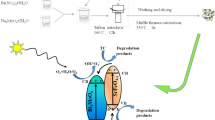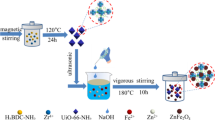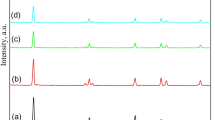Abstract
BiOXs (X = Br, Cl, I, F) are extensively used visible-light-driven photocatalysts and used widely, but except for BiOF, they exhibit an indirect bandgap, and electrons need to cross the K layer to enter the conduction band, which greatly reduces electron–hole complexation. To enhance the photocatalytic activity of BiOXs, we prepared a series of BiOXs materials modified with mesoporous SiO2 using a hybrid solvothermal method with microwave assistance. It was demonstrated using XRD, SEM, XPS, UV–vis DRS, and PL methods that the two-dimensional layered BiOXs were successfully complexed with mesoporous SiO2 forming highly active photocatalysts. Under simulated visible-light conditions, the SiO2/BiOXs materials showed very high degradation efficiency for ofloxacin (OFL) and tetracycline hydrochloride (TCH). The photocatalytic degradation efficiency of both SiO2/BiOCl and SiO2/BiOBr for OFL and TCH was up to 100%. The enhanced activity of the photocatalyst was attributed to the formation of a heterogeneous interface between mesoporous SiO2 and two-dimensional layered bismuth halide oxides, thus improving the separation rate of photogenerated carriers. The introduction of mesoporous SiO2 provided more adsorption sites and active sites for antibiotic molecules improving the adsorption performance of BiOX. In addition, the quenching experiments showed that ·O2− was the main reactant for OFL and TCH. This study demonstrates feasible preparation of low-cost, simple, and efficient photocatalysts, offering promising application potential for photocatalytic degradation of antibiotic contaminants in water.










Similar content being viewed by others
Data availability
The authors confirm that the data supporting the fundings of this study are available the article.
References
K. Kumar, S.C. Gupta, Y. Chander, A.K. Singh, Antibiotic use in agriculture and its impact on the terrestrial environment. Adv. Agron. (2005). https://doi.org/10.1016/s0065-2113(05)87001-4
S. Li, W. Shi, W. Liu, H. Li, W. Zhang, J. Hu, Y. Ke, W. Sun, J. Ni, A duodecennial national synthesis of antibiotics in China’s major rivers and seas (2005–2016). Sci. Total Environ. 615, 906–917 (2018). https://doi.org/10.1016/j.scitotenv.2017.09.328
H. Liu, X. Zhou, H. Huang, J. Zhang, Prevalence of antibiotic resistance genes and their association with antibiotics in a wastewater treatment plant: process distribution and analysis. Water 11, 12 (2019). https://doi.org/10.3390/w11122495
J. Radjenovic, M. Petrovic, D. Barcelo, Fate and distribution of pharmaceuticals in wastewater and sewage sludge of the conventional activated sludge (CAS) and advanced membrane bioreactor (MBR) treatment. Water Res. 43(3), 831–841 (2009). https://doi.org/10.1016/j.watres.2008.11.043
T. Deblonde, C. Cossu-Leguille, P. Hartemann, Emerging pollutants in wastewater: a review of the literature. Int. J. Hyg. Environ. Health 214(6), 442–448 (2011). https://doi.org/10.1016/j.ijheh.2011.08.002
K.G. Karthikeyan, M.T. Meyer, Occurrence of antibiotics in wastewater treatment facilities in Wisconsin, USA. Sci. Total Environ. 361(1–3), 196–207 (2006). https://doi.org/10.1016/j.scitotenv.2005.06.030
A.J. Watkinson, E.J. Murby, S.D. Costanzo, Removal of antibiotics in conventional and advanced wastewater treatment: implications for environmental discharge and wastewater recycling. Water Res. 41(18), 4164–4176 (2007). https://doi.org/10.1016/j.watres.2007.04.005
H. Ilyas, E. van Hullebusch, Role of design and operational factors in the removal of pharmaceuticals by constructed wetlands. Water (2019). https://doi.org/10.3390/w11112356
C.B. Chidambara Raj, H. Li Quen, Advanced oxidation processes for wastewater treatment: Optimization of UV/H2O2 process through a statistical technique. Chem. Eng. Sci 60(19), 5305–5311 (2005). https://doi.org/10.1016/j.ces.2005.03.065
Z. Cai, A.D. Dwivedi, W.-N. Lee, X. Zhao, W. Liu, M. Sillanpää, D. Zhao, C.-H. Huang, J. Fu, Application of nanotechnologies for removing pharmaceutically active compounds from water: development and future trends. Environ. Sci. Nano 5(1), 27–47 (2018). https://doi.org/10.1039/c7en00644f
Y. Liu, W.J. Son, J. Lu, B. Huang, Y. Dai, M.H. Whangbo, Composition dependence of the photocatalytic activities of BiOCl(1–x)Br(x) solid solutions under visible light. Chemistry 17(34), 9342–9349 (2011). https://doi.org/10.1002/chem.201100952
M. Jia, X. Hu, S. Wang, Y. Huang, L. Song, Photocatalytic properties of hierarchical BiOXs obtained via an ethanol-assisted solvothermal process. J. Environ. Sci. (China) 35, 172–180 (2015). https://doi.org/10.1016/j.jes.2014.09.045
X. Zhang, Z.H. Ai, F.L. Jia, L.Z. Zhang, Generalized one-pot synthesis, characterization, and photocatalytic activity of hierarchical BiOX (X = Cl, Br, I) nanoplate microspheres. J. Phys Chem. C 112(3), 747–753 (2008). https://doi.org/10.1021/jp077471t
J. Pan, J. Liu, S. Zuo, U.A. Khan, Y. Yu, B. Li, Structure of Z-scheme CdS/CQDs/BiOCl heterojunction with enhanced photocatalytic activity for environmental pollutant elimination. Appl. Surf. Sci 444, 177–186 (2018). https://doi.org/10.1016/j.apsusc.2018.01.189
X. Zhang, B. Li, J. Wang, Y. Yuan, Q. Zhang, Z. Gao, L.M. Liu, L. Chen, The stabilities and electronic structures of single-layer bismuth oxyhalides for photocatalytic water splitting. Phys. Chem. Chem. Phys. 16(47), 25854–25861 (2014). https://doi.org/10.1039/c4cp03166k
Q. Zhang, J.F. Mao, W.K. Pang, T. Zheng, V. Sencadas, Y.Z. Chen, Y.J. Liu, Z.P. Guo, Boosting the potassium storage performance of alloy-based anode materials via electrolyte salt chemistry. Adv. Energy Mater. (2018). https://doi.org/10.1002/aenm.201703288
L.C. Lee, T.N. Huq, J.L. MacManus-Driscoll, R.L.Z. Hoye, Research update: Bismuth-based perovskite-inspired photovoltaic materials. APL Mater. (2018). https://doi.org/10.1063/1.5029484
C. Wu, Q. Zhang, G. Liu, Z. Zhang, D. Wang, B. Qu, Z. Chen, L. Xiao, From Pb to Bi: a promising family of pb-free optoelectronic materials and devices. Adv. Energy Mater. (2019). https://doi.org/10.1002/aenm.201902496
L. Zhang, K. Wang, B. Zou, Bismuth halide perovskite-like materials: current opportunities and challenges. Chemsuschem 12(8), 1612–1630 (2019). https://doi.org/10.1002/cssc.201802930
Z. Wang, M. Chen, D. Huang, G. Zeng, P. Xu, C. Zhou, C. Lai, H. Wang, M. Cheng, W. Wang, Multiply structural optimized strategies for bismuth oxyhalide photocatalysis and their environmental application. Chem. Eng. J Prog 374, 1025–1045 (2019). https://doi.org/10.1016/j.cej.2019.06.018
H. Zhang, L. Liu, Z. Zhou, Towards better photocatalysts: first-principles studies of the alloying effects on the photocatalytic activities of bismuth oxyhalides under visible light. Phys. Chem. Chem. Phys. 14(3), 1286–1292 (2012). https://doi.org/10.1039/c1cp23516h
X. Wu, G. Li, Z. Leng, S. Wang, N. Zhang, Y. Wang, J. Li, L. Li, Effect of alloyed BiOClxBr1-x nanosheets thickness on the photocatalytic performance. Chem. Select 4(5), 1757–1762 (2019). https://doi.org/10.1002/slct.201803935
X. Jin, L. Ye, H. Wang, Y. Su, H. Xie, Z. Zhong, H. Zhang, Bismuth-rich strategy induced photocatalytic molecular oxygen activation properties of bismuth oxyhalogen: the case of Bi24O31Cl10. Appl. Catal. B Environ 165, 668–675 (2015). https://doi.org/10.1016/j.apcatb.2014.10.075
J. Xiong, P. Song, J. Di, H. Li, Bismuth-rich bismuth oxyhalides: a new opportunity to trigger high-efficiency photocatalysis. J. Mater. Chem. A 8(41), 21434–21454 (2020). https://doi.org/10.1039/d0ta06044e
M. Guan, C. Xiao, J. Zhang, S. Fan, R. An, Q. Cheng, J. Xie, M. Zhou, B. Ye, Y. Xie, Vacancy associates promoting solar-driven photocatalytic activity of ultrathin bismuth oxychloride nanosheets. J. Am. Chem. Soc. 135(28), 10411–10417 (2013). https://doi.org/10.1021/ja402956f
H. Wang, D. Yong, S. Chen, S. Jiang, X. Zhang, W. Shao, Q. Zhang, W. Yan, B. Pan, Y. Xie, Oxygen-vacancy-mediated exciton dissociation in BiOBr for boosting charge-carrier-involved molecular oxygen activation. J. Am. Chem. Soc 140(5), 1760–1766 (2018). https://doi.org/10.1021/jacs.7b10997
W.T. Li, W.Z. Huang, H. Zhou, H.Y. Yin, Y.F. Zheng, X.C. Song, Synthesis of Zn2+ doped BiOCl hierarchical nanostructures and their exceptional visible light photocatalytic properties. J. Alloys Compd. 638, 148–154 (2015). https://doi.org/10.1016/j.jallcom.2015.03.103
M. Gao, D. Zhang, X. Pu, H. Li, W. Li, X. Shao, D. Lv, B. Zhang, J. Dou, Combustion synthesis of Fe-doped BiOCl with high visible-light photocatalytic activities. Sep. Purif. Technol 162, 114–119 (2016). https://doi.org/10.1016/j.seppur.2016.02.024
X. Han, S. Dong, C. Yu, Y. Wang, K. Yang, J. Sun, Controllable synthesis of Sn-doped BiOCl for efficient photocatalytic degradation of mixed-dye wastewater under natural sunlight irradiation. J. Alloys Compd. 685, 997–1007 (2016). https://doi.org/10.1016/j.jallcom.2016.06.298
J. Cao, B. Xu, H. Lin, B. Luo, S. Chen, Novel heterostructured Bi2S3/BiOI photocatalyst: facile preparation, characterization and visible light photocatalytic performance. Dalton Trans. 41(37), 11482–11490 (2012). https://doi.org/10.1039/c2dt30883e
L. Sun, L. Xiang, X. Zhao, C.-J. Jia, J. Yang, Z. Jin, X. Cheng, W. Fan, Enhanced visible-light photocatalytic activity of BiOI/BiOCl heterojunctions: key role of crystal facet combination. ACS Catal. 5(6), 3540–3551 (2015). https://doi.org/10.1021/cs501631n
J.C. Wang, H.C. Yao, Z.Y. Fan, L. Zhang, J.S. Wang, S.Q. Zang, Z.J. Li, Indirect Z-scheme BiOI/g-C3N4 photocatalysts with enhanced photoreduction CO2 activity under visible light irradiation. ACS Appl. Mater. Interfaces 8(6), 3765–3775 (2016). https://doi.org/10.1021/acsami.5b09901
W. Li, X. Jia, P. Li, B. Zhang, H. Zhang, W. Geng, Q. Zhang, Hollow mesoporous SiO2–BiOBr nanophotocatalyst: synthesis, characterization and application in photodegradation of organic dyes under visible-light irradiation. ACS Sustain. Chem. Eng 3(6), 1101–1110 (2015). https://doi.org/10.1021/acssuschemeng.5b00033
F. Shen, L. Zhou, J. Shi, M. Xing, J. Zhang, Preparation and characterization of SiO2/BiOX (X = Cl, Br, I) films with high visible-light activity. RSC Adv. 5(7), 4918–4925 (2015). https://doi.org/10.1039/c4ra10227d
Y.R. Yao, W.Z. Huang, H. Zhou, H.Y. Yin, Y.F. Zheng, X.C. Song, A novel Fe3O4@SiO2@BiOBr photocatalyst with highly active visible light photocatalytic properties. Mater. Chem. Phys 148(3), 896–902 (2014). https://doi.org/10.1016/j.matchemphys.2014.08.067
M. Khan, C.S.L. Fung, A. Kumar, J. He, I.M.C. Lo, Unravelling mechanistic reasons for differences in performance of different Ti- and Bi-based magnetic photocatalysts in photocatalytic degradation of PPCPs. Sci. Total Environ. 686, 878–887 (2019). https://doi.org/10.1016/j.scitotenv.2019.05.340
X. Ji, L. Ge, C. Liu, Z. Tang, Y. Xiao, W. Chen, Z. Lei, W. Gao, S. Blake, D. De, B. Shi, X. Zeng, N. Kong, X. Zhang, W. Tao, Capturing functional two-dimensional nanosheets from sandwich-structure vermiculite for cancer theranostics. Nat. Commun. 12(1), 1124 (2021). https://doi.org/10.1038/s41467-021-21436-5
X. Zhang, L.W. Wang, C.Y. Wang, W.K. Wang, Y.L. Chen, Y.X. Huang, W.W. Li, Y.J. Feng, H.Q. Yu, Synthesis of BiOClxBr1–x nanoplate solid solutions as a robust photocatalyst with tunable band structure. Chemistry 21(33), 11872–11877 (2015). https://doi.org/10.1002/chem.201501427
M. Hu, R. Li, X. Zhang, C. Zhang, H. Zhang, C. Fan, J. Zhu, HCl post-processing BiOBr photocatalyst: structure, morphology, and composition and their impacts to activity. RSC Adv. 7(79), 50079–50086 (2017). https://doi.org/10.1039/c7ra08871j
G. Liu, H. Xu, D. Li, Z. Zou, Q. Li, D. Xia, BiOCl/BiOBr heterojunction with rich oxygen vacancies induced by ultraviolet and its enhanced photocatalytic performance. Eur. J. Inorg. Chem 2019(46), 4887–4893 (2019). https://doi.org/10.1002/ejic.201900948
C. Zhao, Y. Liang, W. Li, X. Chen, Y. Tian, D. Yin, Q. Zhang, 3D BiOBr/BiOCl heterostructure microspheres with enhanced photocatalytic activity. J. Mater. Sci. Mater. Electron 31(3), 1868–1878 (2019). https://doi.org/10.1007/s10854-019-02706-x
W. Maisang, S. Promnopas, S. Kaowphong, S. Narksitipan, S. Thongtem, S. Wannapop, A. Phuruangrat, T. Thongtem, Microwave-assisted hydrothermal synthesis of BiOBr/BiOCl flowerlike composites used for photocatalysis. Res. Chem. Intermed 46(4), 2117–2135 (2020). https://doi.org/10.1007/s11164-020-04082-2
M. Thommes, K. Kaneko, A.V. Neimark, J.P. Olivier, F. Rodriguez-Reinoso, J. Rouquerol, K.S.W. Sing, Physisorption of gases, with special reference to the evaluation of surface area and pore size distribution (IUPAC Technical Report). Pure Appl. Chem 87(9–10), 1051–1069 (2015). https://doi.org/10.1515/pac-2014-1117
S.J. Zhang, J.F. Yang, Microwave-assisted synthesis of BiOCl/BiOBr composites with improved visible-light photocatalytic activity. Ind. Eng. Chem. Res 54(41), 9913–9919 (2015). https://doi.org/10.1021/acs.iecr.5b02332
V. Bhatia, A.K. Ray, A. Dhir, Enhanced photocatalytic degradation of ofloxacin by co-doped titanium dioxide under solar irradiation. Sep. Purif. Technol 161, 1–7 (2016). https://doi.org/10.1016/j.seppur.2016.01.028
A. Kaur, A. Umar, W.A. Anderson, S.K. Kansal, Facile synthesis of CdS/TiO2 nanocomposite and their catalytic activity for ofloxacin degradation under visible illumination. J. Photoch. Photobio. A 360, 34–43 (2018). https://doi.org/10.1016/j.jphotochem.2018.04.021
H. Bouyarmane, C. El Bekkali, J. Labrag, I. Es-saidi, O. Bouhnik, H. Abdelmoumen, A. Laghzizil, J.M. Nunzi, D. Robert, Photocatalytic degradation of emerging antibiotic pollutants in waters by TiO2/Hydroxyapatite nanocomposite materials. Surf. Interfaces (2021). https://doi.org/10.1016/j.surfin.2021.101155
H. Jia, D. Ma, S. Zhong, L. Li, L. Li, L. Xu, B. Li, Boosting photocatalytic activity under visible-light by creation of PCN-222/g-C3N4 heterojunctions. Chem. Eng. J. 368, 165–174 (2019). https://doi.org/10.1016/j.cej.2019.02.147
M.V. Mamba, 1D/2D MnWO4 nanorods anchored on g-C3N4 nanosheets for enhanced photocatalytic degradation ofloxacin under visible light irradiation. Colloids Surf A (2019). https://doi.org/10.1016/j.colsurfa.2019.123845
D. Zhang, J. Qi, H. Ji, S. Li, L. Chen, T. Huang, C. Xu, X. Chen, W. Liu, Photocatalytic degradation of ofloxacin by perovskite-type NaNbO3 nanorods modified g-C3N4 heterojunction under simulated solar light: Theoretical calculation, ofloxacin degradation pathways and toxicity evolution. Chem. Eng. J (2020). https://doi.org/10.1016/j.cej.2020.125918
P. Praus, A. Smýkalová, K. Foniok, V. Novák, J. Hrbáč, Doping of graphitic carbon nitride with oxygen by means of cyanuric acid: Properties and photocatalytic applications. J. Environ. Chem. Eng 9, 4 (2021). https://doi.org/10.1016/j.jece.2021.105498
H. Yin, H. Shi, L. Sun, D. Xia, X. Yuan, Construction of Ag2O-modified g-C3N4 photocatalyst for rapid visible light degradation of ofloxacin. Environ. Sci. Pollut. Res. Int. 28(9), 11650–11664 (2021). https://doi.org/10.1007/s11356-020-11390-y
S. Adhikari, D.-H. Kim, Synthesis of Bi2S3/Bi2WO6 hierarchical microstructures for enhanced visible light driven photocatalytic degradation and photoelectrochemical sensing of ofloxacin. Chem. Eng. J 354, 692–705 (2018). https://doi.org/10.1016/j.cej.2018.08.087
Q. Hao, X. Niu, C. Nie, S. Hao, W. Zhou, J. Ge, D. Chen, W. Yao, Highly efficient g-C3N4/SiO2 heterojunction: the role of SiO2 for the enhanced visible light photocatalytic activity. Phys. Chem. Chem. Phys. 18(46), 31410–31418 (2016). https://doi.org/10.1039/c6cp06122b
L. Li, M. Zhang, Y. Liu, X. Zhang, Hierarchical assembly of BiOCl nanosheets onto bicrystalline TiO2 nanofiber: enhanced photocatalytic activity based on photoinduced interfacial charge transfer. J. Colloid Interface Sci 435, 26–33 (2014). https://doi.org/10.1016/j.jcis.2014.08.022
Acknowledgements
Thanks for the contribution of everyone in our research team.
Author information
Authors and Affiliations
Contributions
ZP: formulation and evolution of overarching research goals and aims, writing-review & editing. HG: writing-original draft, development and design of methodology, investigation. JX: investigation, visualization, data curation. ZF: investigation, visualization, data curation. CL: Supervision. LZ: investigation. WC: investigation.
Corresponding author
Ethics declarations
Conflict of interest
There are no conflicts to declare.
Additional information
Publisher's Note
Springer Nature remains neutral with regard to jurisdictional claims in published maps and institutional affiliations.
Supplementary Information
Below is the link to the electronic supplementary material.
Rights and permissions
Springer Nature or its licensor holds exclusive rights to this article under a publishing agreement with the author(s) or other rightsholder(s); author self-archiving of the accepted manuscript version of this article is solely governed by the terms of such publishing agreement and applicable law.
About this article
Cite this article
Pei, Z., Guo, H., Xu, J. et al. Synthesis, mechanism and characterization of SiO2/BiOX (X = Br, Cl): efficient photocatalytic degradation of various antibiotics under visible-light irradiation. J Mater Sci: Mater Electron 33, 21497–21511 (2022). https://doi.org/10.1007/s10854-022-08941-z
Received:
Accepted:
Published:
Issue Date:
DOI: https://doi.org/10.1007/s10854-022-08941-z




